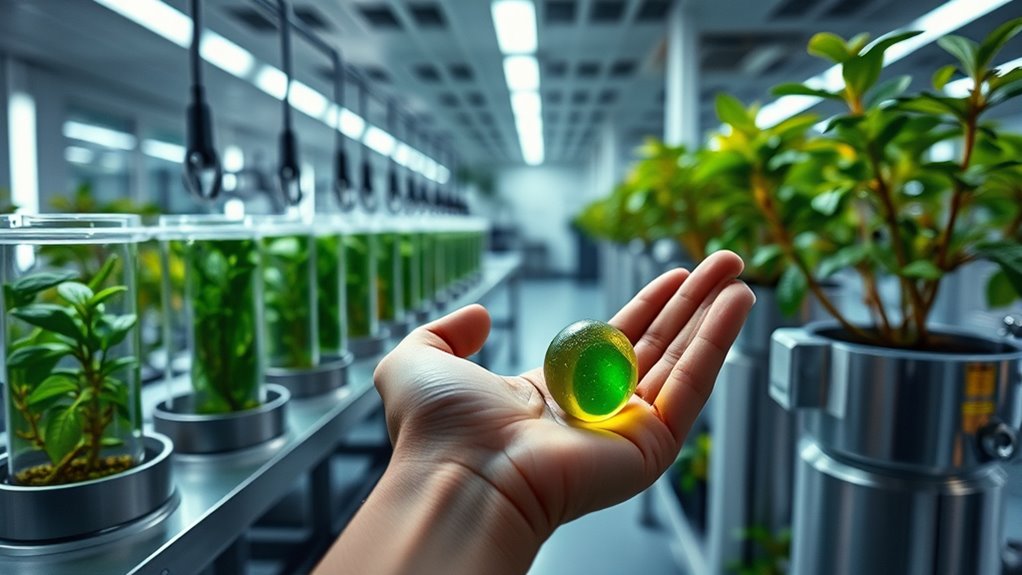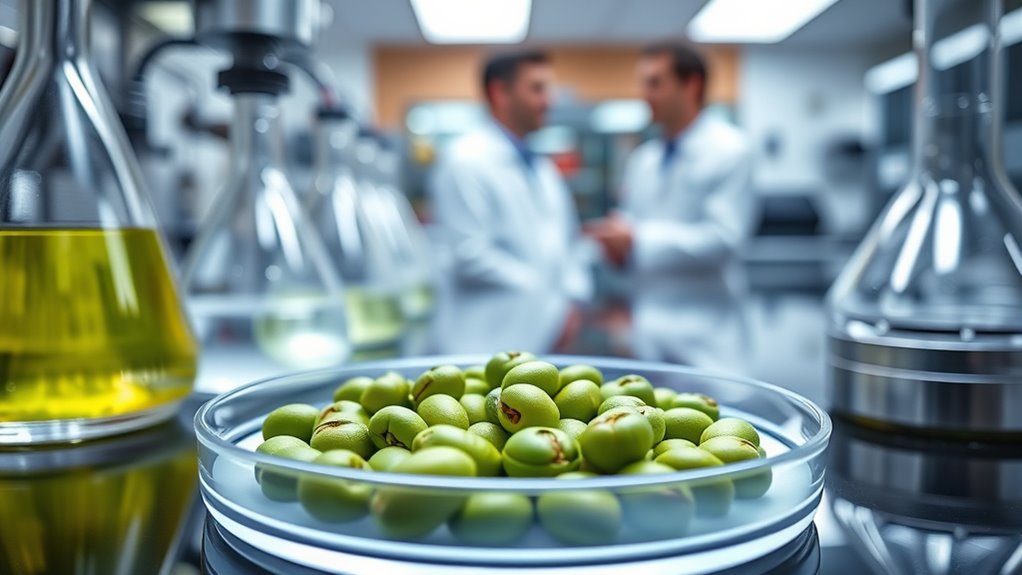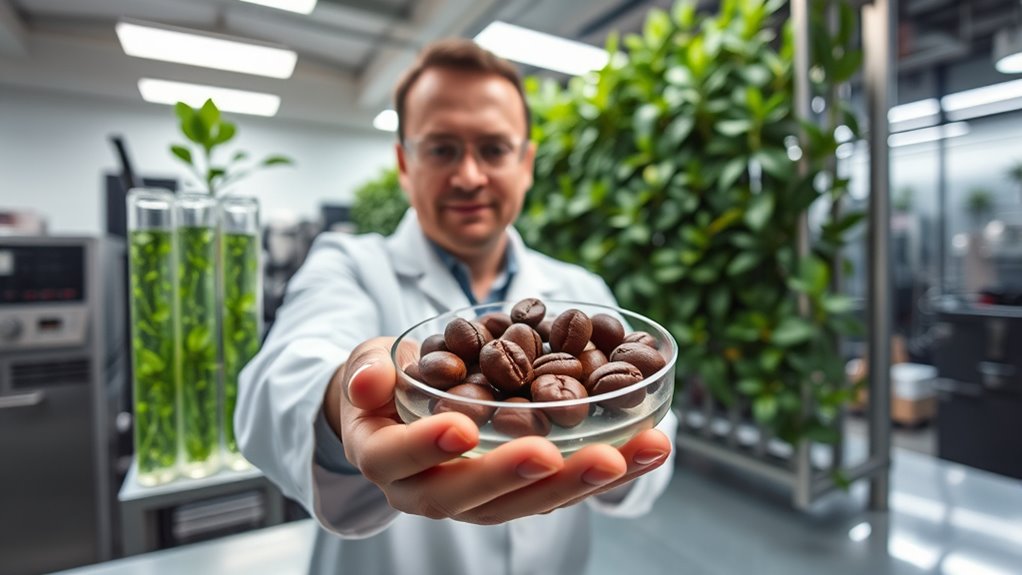The future of coffee lies in lab-grown beans, a sustainable solution to the looming coffee crisis. As climate change threatens traditional cultivation, lab-cultured coffee offers a way to enjoy your favorite brew without harming the environment. It reduces deforestation, while providing opportunities for unique and tailored flavors. Though challenges exist in flavor complexity and regulatory approvals, the advancements made could revolutionize your coffee experience. Discover more about how this innovation could change your next cup.
Key Takeaways
- Lab-grown coffee offers a sustainable alternative to traditional coffee, reducing deforestation and environmental impact associated with conventional farming methods.
- The production of lab-cultured coffee involves cultivating coffee cells in bioreactors, aiming to replicate the flavors of traditional coffee.
- Current challenges in lab-grown coffee include achieving complex flavor profiles and overcoming regulatory hurdles for market readiness.
- Consumer interest in unique and sustainable beverages, especially among younger demographics, drives the demand for lab-grown coffee innovations.
- Ongoing research focuses on refining flavor and customization, promising a satisfying and eco-friendly coffee experience for consumers.
The Global Coffee Crisis: An Urgent Call for Change

As climate change drastically alters our environment, the global coffee crisis looms larger than ever. By 2050, half of the land used for traditional coffee cultivation may become unproductive due to rising temperatures and erratic rainfall.
Meanwhile, global demand for coffee is set to double, reaching 6 billion cups daily. This intensifying pressure is an environmental problem that threatens livelihoods and biodiversity, as traditional coffee production often leads to deforestation.
You can see the urgency for sustainable alternatives; conventional methods are increasingly unsustainable. Innovative solutions are vital to stabilize supply chains and guarantee the future of coffee.
Addressing this crisis now means embracing change and seeking new ways to enjoy your daily brew without compromising our planet.
Understanding Cell-Cultured Coffee: A New Frontier

As you explore cell-cultured coffee, you’ll find that the production techniques involve cultivating coffee cells in a lab to mimic traditional flavors.
However, these methods come with challenges, particularly in achieving the complex flavor profile we love in regular coffee.
Understanding these innovations could reshape your coffee experience and address sustainability issues in the industry.
Production Techniques Explained
While traditional coffee farming faces numerous sustainability challenges, cell-cultured coffee offers an innovative solution. This method begins with extracting coffee cell biomass from a tissue sample and cultivating it in a lab.
The cells grow in bioreactors, forming a callus mass that’s dried, ground, and roasted. Different production techniques are applied to enhance flavor profiles, replicating the sensory experience of conventional coffee.
Initial taste tests reveal that lab-grown coffee can exhibit smoky flavors, but it currently lacks some Maillard reaction products that give farm-grown coffee its unique taste.
Ongoing research aims to refine these production techniques, improving both the flavor and viability of cell-cultured coffee, while addressing pressing sustainability concerns in the coffee industry.
Flavor Profile Challenges
Although lab-grown coffee represents a groundbreaking advancement in the industry, it still struggles to capture the rich and complex flavor profiles that consumers expect from traditional coffee.
Here are some key challenges facing lab-grown coffee’s taste:
- Lacks variety of cell types needed for a complex flavor profile
- Initial taste tests show dominant smoky flavors, missing key aroma compounds
- Ongoing research aims to refine processing techniques for better taste
- Absence of certain flavor compounds hinders consumer satisfaction
- Consumer acceptance relies on bridging the taste gap with traditional coffee
As research progresses, the hope is that lab-grown coffee can evolve to meet these challenges, ensuring it delivers a satisfying taste that resonates with coffee lovers everywhere.
Environmental Benefits of Lab-Grown Coffee Production

Lab-grown coffee is a game changer for the environment, cutting down the need for land and helping to protect our precious rainforests.
By reducing carbon emissions associated with traditional coffee farming, you can enjoy your cup of coffee guilt-free.
Plus, this innovative approach guarantees a more sustainable future for coffee production.
Reduced Deforestation Impact
As traditional coffee consumption continues to drive deforestation, the emergence of lab-grown coffee offers a promising solution to this environmental crisis.
By utilizing cellular agriculture techniques, lab-grown coffee markedly reduces deforestation impacts:
- Each cup of traditional coffee contributes to about one square inch of rainforest destruction.
- Lab-grown coffee eliminates the need for expanding plantations into biodiverse ecosystems.
- Cultivating coffee cells in bioreactors requires less land and mitigates environmental degradation.
- This method stabilizes supply chains, making coffee less vulnerable to climate change.
- Lifecycle assessments show lab-grown coffee has a lower overall environmental impact.
Embracing lab-grown coffee can help you enjoy your favorite beverage while actively participating in reducing deforestation and protecting our planet.
Lower Carbon Emissions
The environmental advantages of lab-grown coffee extend to considerably lower carbon emissions, making it a game-changer in the coffee industry.
Traditional coffee farming contributes greatly to greenhouse gas emissions, but lab-grown coffee production drastically reduces these levels. Each cup of conventional coffee contributes to rainforest destruction, but with lab-grown methods, you won’t need to encroach on biodiverse ecosystems.
Utilizing bioreactor technology not only cuts down on water usage but also stabilizes supply chains disrupted by climate change. By producing coffee in controlled lab environments, you guarantee a consistent and reliable supply, further minimizing the environmental impact associated with conventional farming practices.
Embracing lab-grown coffee can help combat climate change while enjoying your favorite brew guilt-free.
Challenges in Developing Lab-Grown Coffee

While many are excited about the prospect of lab-grown coffee, several challenges hinder its development. Here’s what you need to know:
- Taste: Current lab-grown coffee lacks the complexity of traditional flavors due to undifferentiated cells.
- Regulatory hurdles: Pending approvals limit extensive taste tests and delay market readiness.
- Sustainability concerns: The nutrient medium often uses sugars from traditional agriculture, raising questions about environmental impact.
- Economic challenges: Securing venture capital funding is tough for start-ups in this sector, slowing innovation.
- Research needs: Further R&D is essential to optimize taste and enhance sensory profiles for consumer acceptance.
Addressing these challenges will be vital for the future success of lab-grown coffee.
Innovations in Flavor Profiles and Consumer Experience

Innovations in flavor profiles and consumer experience are transforming the coffee landscape, offering exciting possibilities for coffee lovers.
Lab-grown coffee enables the creation of unique flavors tailored to your preferences, pushing the boundaries of traditional coffee. Initial taste tests show dominant smoky notes, hinting at a future rich in complex flavors. The production process allows for customized blends, catering to diverse interests and enhancing your coffee experience.
As you become more conscious of sustainability and ethical practices, lab-grown coffee aligns with your values, providing an eco-friendly choice without sacrificing taste.
With ongoing research into refining flavor and aroma, you can look forward to a coffee experience that’s both innovative and deeply satisfying. Enjoy the journey into this new coffee frontier!

As lab-grown coffee introduces exciting new flavors and sustainable options, understanding the regulatory landscape becomes vital for its successful market introduction.
Since it’s classified as a “novel food,” lab-grown coffee must navigate a rigorous approval process that can take up to two years.
Here are key points to evaluate:
- Extensive safety assessments are mandatory.
- Regulatory compliance is essential for market entry.
- Unlike traditional coffee, delays are expected.
- Stakeholders must address consumer acceptance for success.
- Safety, labeling, and taste concerns need to be prioritized.
The Role of Collaboration in Advancing Coffee Technology

Collaboration is essential to overcoming the challenges of lab-grown coffee production, especially in a rapidly evolving market. By partnering with start-ups and research institutions, you can enhance efforts to optimize flavor and improve production efficiency.
This teamwork fosters transparency and builds consumer trust in the emerging cultured coffee sector. Since consumer acceptance largely hinges on taste, collaborative research is crucial to bridging the gap between lab-grown and traditional coffee flavors.
Initial surveys show that younger demographics are particularly open to lab-grown coffee, indicating a promising market. By implementing effective collaborative marketing strategies, you can promote these sustainable alternatives and encourage wider adoption.
Together, we can revolutionize the coffee industry and pave the way for a more sustainable future.
Envisioning a Sustainable Future for Coffee Consumption

With the coffee industry facing unprecedented challenges, envisioning a sustainable future for coffee consumption becomes imperative.
Lab-grown coffee presents a promising solution, greatly reducing the environmental impact of traditional coffee production. As consumer preferences shift, here are key considerations for a sustainable coffee future:
- Reduces land expansion into biodiverse ecosystems
- Stabilizes supply chains impacted by climate change
- Addresses ethical concerns related to traditional farming
- Caters to younger consumers’ demand for sustainability
- Opens new possibilities for flavor customization
Additionally, the rising popularity of specialty teas highlights the growing consumer interest in unique beverage options that align with sustainability goals. Furthermore, embracing plant-based diets can also contribute to a more sustainable food system, reducing the overall environmental impact of agriculture.
Frequently Asked Questions
Can Coffee Be Grown Artificially?
Yes, coffee can be grown artificially through advanced biotechnological methods.
Scientists extract DNA from coffee plants and cultivate the cells in controlled lab environments. This process allows them to replicate the essential compounds that give coffee its unique aroma and flavor.
While lab-grown coffee shows promise, it still faces challenges in perfectly mimicking the complex tastes of traditionally grown coffee.
However, innovations in this field could revolutionize how you enjoy your daily brew.
Can Coffee Be Grown in a Lab?
They say you can’t make a silk purse out of a sow’s ear, but lab-grown coffee challenges that notion.
Yes, you can grow coffee in a lab! By using advanced techniques, scientists cultivate coffee cell biomass, mimicking the traditional growing process.
This innovative method aims to replicate the taste and aroma we love, while addressing environmental concerns.
Is It Illegal to Grow Coffee Beans in the USA?
No, it isn’t illegal to grow coffee beans in the USA.
You can cultivate coffee plants in certain regions, especially in Hawaii, where Kona coffee is famous. If you’re in areas with the right climate, like parts of California, you can also try your hand at growing them.
Just make sure you follow local agricultural guidelines. As interest in coffee cultivation rises, you might find it a rewarding hobby or venture.
Can You Drink 20 Year Old Coffee Beans?
You can technically drink 20-year-old coffee beans, but you won’t enjoy it.
Over time, these beans lose their aromatic oils and flavor, resulting in a stale, flat taste. While they’re not harmful, brewed coffee from old beans lacks the rich flavors and aromas you expect.
For the best experience, stick to freshly roasted beans within two weeks to a month. Your taste buds will thank you for choosing quality coffee!
Conclusion
As the sun sets on traditional coffee cultivation, a new dawn rises with lab-grown beans. You’re not just sipping a cup; you’re part of a revolution, nurturing the earth while indulging in rich flavors. Each sip is a step toward sustainability, a bridge between innovation and nature. Together, we can cultivate a future where every brew tells a story of resilience and hope. So, let’s raise our mugs to the journey ahead and savor the possibilities that await.









